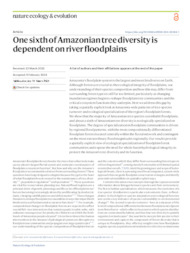One sixth of Amazonian tree diversity is dependent on river floodplains.
One sixth of Amazonian tree diversity is dependent on river floodplains.
Autoria: HOUSEHOLDER, J. E.; WITTMANN, F.; SCHÖNGART, J.; PIEDADE, M. T. F.; JUNK, W. J.; LATRUBESSE, E. M.; QUARESMA, A. C.; DEMARCHI, L. O.; LOBO, G. de S.; AGUIAR, D. P. P. de; ASSIS, R. L.; LOPES, A.; PAROLIN, P.; AMARAL, I. L. do; COELHO, L. de S.; MATOS, F. D. de A.; LIMA FILHO, D. de A.; SALOMÃO, R. P.; CASTILHO, C. V. de; GUEVARA-ANDINO, J. E.; CARIM, M. de J. V.; PHILLIPS, O. L.; LÓPEZ, D. C.; MAGNUSSON, W. E.; SABATIER, D.; REVILLA, J. D. C.; MOLINO, J.; IRUME, M. V.; MARTINS, M. P.; GUIMARÃES, J. R. da S.; RAMOS, J. F.; RODRIGUES, D. de J.; BÁNKI, O. S.; PERES, C. A.; PITMAN, N. C. A.; HAWES, J. E.; ALMEIDA, E. J.; BARBOSA, L. F.; CAVALHEIRO, L.; SANTOS, M. C. V. dos; LUIZE, B. G.; NOVO, E. M. M. de L.; VARGAS, P. N.; SILVA, T. S. F.; VENTICINQUE, E. M.; MANZATTO, A. G.; REIS, N. F. C.; TERBORGH, J.; CASULA, K. R.; COSTA, F. R. C.; CORONADO, E. N. H.; MENDOZA, A. M.; MONTERO, J. C.; FELDPAUSCH, T. R.; C, G. A. A.; BARALOTO, C.; ARBOLEDA, N. C.; ENGEL, J.; PETRONELLI, P.; ZARTMAN, C. E.; KILLEEN, T. J.; RINCÓN, L. M.; MARIMON, B. S.; MARIMON-JUNIOR, B. H.; SCHIETTI, J.; SOUSA, T. R.; VASQUEZ, R.; MOSTACEDO, B.; AMARAL, D. D. do; CASTELLANOS, H.; MEDEIROS, M. B. de; SIMON, M. F.; ANDRADE, A.; CAMARGO, J. L.; LAURANCE, W. F.; LAURANCE, S. G. W.; FARIAS, E. de S.; LOPES, M. A.; MAGALHÃES, J. L. L.; NASCIMENTO, H. E. M.; QUEIROZ, H. L. de; BRIENEN, R.; STEVENSON, P. R.; ARAUJO-MURAKAMI, A.; BAKER, T. R.; CINTRA, B. B. L.; FEITOSA, Y. O.; MOGOLLÓN, H. F.; NORONHA, J. C.; BARBOSA, F. R.; CARPANEDO, R. de S.; DUIVENVOORDEN, J. F.; SILMAN, M. R.; FERREIRA, L. V.; LEVIS, C.; LOZADA, J. R.; COMISKEY, J. A.; DRAPER, F. C.; TOLEDO, J. J. de; DAMASCO, G.; DÁVILA, N.; GARCÍA-VILLACORTA, R.; VICENTINI, A.; VALVERDE, F. C.; ALONSO, A.; ARROYO, L.; DALLMEIER, F.; GOMES, V. H. F.; JIMENEZ, E. M.; NEILL, D.; MORA, M. C. P.; CARVALHO, F. A.; SOUZA, F. C. de; FEELEY, K. J.; GRIBEL, R.; PANSONATO, M. P.; PAREDES, M. R.; BARLOW, J.; BERENGUER, E.; DEXTER, K. G.; FERREIRA, J. N.; FINE, P. V. A.; GUEDES, M. C.; HUAMANTUPA-CHUQUIMACO, I.; LICONA, J. C.; PENNINGTON, T.; ZEGARRA, B. E. V.; VOS, V. A.; CERÓN, C.; FONTY, É.; HENKEL, T. W.; MAAS, P.; POS, E.; SILVEIRA, M.; STROPP, J.; THOMAS, R.; DALY, D.; MILLIKEN, W.; MOLINA, G. P.; VIEIRA, I. C. G.; ALBUQUERQUE, B. W.; CAMPELO, W.; EMILIO, T.; FUENTES, A.; KLITGAARD, B.; PENA, J. L. M.; SOUZA, P. F.; TELLO, J. S.; VRIESENDORP, C.; CHAVE, J.; FIORE, A. D.; HILÁRIO, R. R.; PEREIRA, L. de O.; PHILLIPS, J. F.; RIVAS-TORRES, G.; ANDEL, T. R. V.; HILDEBRAND, P. V.; BALEE, W.; BARBOSA, E. M.; BONATES, L. C. de M.; DOZA, H. P. D.; GÓMEZ, R. Z.; GONZALES, T.; GONZALES, G. P. G.; HOFFMAN, B.; JUNQUEIRA, A. B.; MALHI, Y.; MIRANDA, I. P. de A.; MOZOMBITE-PINTO, L. F.; PRIETO, A.; RUDAS, A.; RUSCHEL, A. R.; SILVA, N.; VELA, C. I. A.; ZENT, S.; ZENT, E. L.; CANO, A.; MÁRQUEZ, Y. A. C.; CORREA, D. F.; COSTA, J. B. P.; FLORES, B. M.; GALBRAITH, D.; HOLMGREN, M.; KALAMANDEEN, M.; NASCIMENTO, M. T.; OLIVEIRA, A. A.; RAMIREZ-ANGULO, H.; ROCHA, M.; SCUDELLER, V. V.; SIERRA, R.; TIRADO, M.; UMAÑA, M. N.; HEIJDEN, G. V. D.; TORRE, E. V.; REATEGUI, M. A. A.; BAIDER, C.; BALSLEV, H.; CÁRDENAS, S.; CASAS, L. F.; FARFAN-RIOS, W.; FERREIRA, C.; LINARES-PALOMINO, R.; MENDOZA, C.; MESONES, I.; PARADA, G. A.; TORRES-LEZAMA, A.; GIRALDO, L. E. U.; VILLARROEL, D.; ZAGT, R.; ALEXIADES, M. N.; OLIVEIRA, E. A. de; GARCIA-CABRERA, K.; HERNANDEZ, L.; CUENCA, W. P.; PANSINI, S.; PAULETTO, D.; AREVALO, F. R.; SAMPAIO, A. F.; SANDOVAL, E. H. V.; GAMARRA, L. V.; STEEGE, H. T.
Resumo: Amazonia’s floodplain system is the largest and most biodiverse on Earth. Although forests are crucial to the ecological integrity of floodplains, our understanding of their species composition and how this may differ from surrounding forest types is still far too limited, particularly as changing inundation regimes begin to reshape floodplain tree communities and the critical ecosystem functions they underpin. Here we address this gap by taking a spatially explicit look at Amazonia-wide patterns of tree-species turnover and ecological specialization of the region’s floodplain forests. We show that the majority of Amazonian tree species can inhabit floodplains, and about a sixth of Amazonian tree diversity is ecologically specialized on floodplains. The degree of specialization in floodplain communities is driven by regional flood patterns, with the most compositionally differentiated floodplain forests located centrally within the fluvial network and contingent on the most extraordinary flood magnitudes regionally. Our results provide a spatially explicit view of ecological specialization of floodplain forest communities and expose the need for whole-basin hydrological integrity to protect the Amazon’s tree diversity and its function.
Ano de publicação: 2024
Tipo de publicação: Artigo de periódico
Unidade: Embrapa Roraima
Palavras-chave: Amazonian tree species
Observações
1 - Por padrão são exibidas publicações dos últimos 20 anos. Para encontrar publicações mais antigas, configure o filtro ano de publicação, colocando o ano a partir do qual você deseja encontrar publicações. O filtro está na coluna da esquerda na busca acima.
2 - Para ler algumas publicações da Embrapa (apenas as que estão em formato ePub), é necessário ter, no celular ou computador, um desses softwares gratuitos. Sistemas Android: Google Play Livros; IOS: iBooks; Windows e Linux: software Calibre.
Acesse outras publicações
Acesse a Base de Dados da Pesquisa Agropecuária (BDPA) para consultar o acervo completo das bibliotecas da Embrapa.

